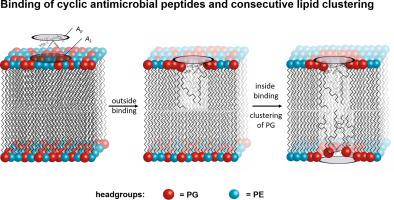当前位置:
X-MOL 学术
›
BBA Biomembr.
›
论文详情
Our official English website, www.x-mol.net, welcomes your
feedback! (Note: you will need to create a separate account there.)
The impact of non-ideality of lipid mixing on peptide induced lipid clustering.
Biochimica et Biophysica Acta (BBA) - Biomembranes ( IF 2.8 ) Pub Date : 2020-03-05 , DOI: 10.1016/j.bbamem.2020.183248 Sebastian Finger 1 , Andreas M Kerth 1 , Margitta Dathe 2 , Alfred Blume 1
Biochimica et Biophysica Acta (BBA) - Biomembranes ( IF 2.8 ) Pub Date : 2020-03-05 , DOI: 10.1016/j.bbamem.2020.183248 Sebastian Finger 1 , Andreas M Kerth 1 , Margitta Dathe 2 , Alfred Blume 1
Affiliation

|
The influence of several antimicrobial trivalent cyclic hexapeptides on the mixing behavior of bilayer lipid membranes containing phosphatidylglycerol (PG) and phosphatidylethanolamine (PE) with varying composition was studied using DSC and ITC. The peptides contained three arginines and three aromatic amino acids and had different sequences. All of them induce clustering of PG-rich clusters with bound peptides after binding. In a previous publication we could show that a correlation between clustering efficacy and the antimicrobial activity of the peptides exists (S. Finger et al., Biochim. Biophys. Acta 1848 (2015) 2998-3006). In the current study we investigated whether the non-ideality of the lipid mixture had any effect on the clustering efficacy and the critical peptide/lipid clustering ratio. We could show that for PG/PE membranes containing 1:1 M ratios and lipids with equal or unequal chain lengths, the amount of clustered PG depended only slightly on the absolute chain length and on the chain length difference between PG and PE. Much larger differences were observed when the PG/ PE mixing ratio was changed. In mixtures of DPPG/DPPE with high PG content, the amount of clustered PG per added peptide was much higher than in PE-rich mixtures. The ITC experiments showed that the critical peptide/lipid ratio for cluster formation is also strongly dependent on the PG/PE ratio in the mixture. In the PG/PE 3:1 mixture, the formation of clusters with bound peptide is much more likely than for mixtures with less PG. For 1:1 and 1:3 lipid mixtures, the critical peptide/lipid ratio for demixing is between 0.002 and 0.004. Therefore, even in these mixtures clustering occurs way below charge saturation of the PG in the mixture and the PG-rich clusters are not charge compensated either. The peptide concentration necessary for inducing clustering amounts to ~8 μM, a value well within the range of minimal inhibitory concentration values observed for the cyclic peptides studied here. Our results show that not only the structure of the cyclic peptide influences the clustering efficacy but also the mixing behavior of the lipids in the bilayers has an influence on the amount of clustering induced by binding of cyclic peptides.
中文翻译:

脂质混合的非理想性对肽诱导的脂质聚集的影响。
使用DSC和ITC研究了几种抗菌三价环六肽对含有磷脂酰甘油(PG)和磷脂酰乙醇胺(PE)的双层脂质膜混合行为的影响。这些肽含有三个精氨酸和三个芳香族氨基酸,并且具有不同的序列。它们全部在结合后诱导富含PG的簇与结合的肽的簇聚。在先前的出版物中,我们可以证明聚类功效与多肽的抗菌活性之间存在相关性(S.Finger等人,Biochim.Biophys.Acta 1848(2015)2998-3006)。在当前的研究中,我们调查了脂质混合物的非理想性是否对聚类功效和关键的肽/脂质聚类比率有任何影响。我们可以证明,对于含有1:1 M比例和链长相等或不相等的脂质的PG / PE膜,成簇PG的数量仅略微依赖于绝对链长以及PG与PE之间的链长差。当改变PG / PE混合比时,观察到更大的差异。在具有高PG含量的DPPG / DPPE混合物中,每个添加的肽的成簇PG的数量远远高于富含PE的混合物。ITC实验表明,簇形成的关键肽/脂质比率也强烈取决于混合物中PG / PE比率。在PG / PE 3:1混合物中,与结合肽的簇相比,与较少PG的混合物更容易形成簇。对于1:1和1:3的脂质混合物,混合的关键肽/脂质比率在0.002至0.004之间。因此,即使在这些混合物中,也会以低于混合物中PG的电荷饱和的方式发生聚集,并且富含PG的簇也不会进行电荷补偿。诱导聚簇所需的肽浓度约为〜8μM,该值完全在此处研究的环状肽的最小抑制浓度范围内。我们的结果表明,不仅环肽的结构影响聚簇功效,而且双层中脂质的混合行为也对环肽结合诱导的聚簇量产生影响。该值完全在此处研究的环肽的最小抑菌浓度值范围内。我们的结果表明,不仅环肽的结构影响聚簇功效,而且双层中脂质的混合行为也对环肽结合诱导的聚簇量产生影响。该值完全在此处研究的环肽的最小抑菌浓度值范围内。我们的结果表明,不仅环肽的结构影响聚簇功效,而且双层中脂质的混合行为也对环肽结合诱导的聚簇量产生影响。
更新日期:2020-03-05
中文翻译:

脂质混合的非理想性对肽诱导的脂质聚集的影响。
使用DSC和ITC研究了几种抗菌三价环六肽对含有磷脂酰甘油(PG)和磷脂酰乙醇胺(PE)的双层脂质膜混合行为的影响。这些肽含有三个精氨酸和三个芳香族氨基酸,并且具有不同的序列。它们全部在结合后诱导富含PG的簇与结合的肽的簇聚。在先前的出版物中,我们可以证明聚类功效与多肽的抗菌活性之间存在相关性(S.Finger等人,Biochim.Biophys.Acta 1848(2015)2998-3006)。在当前的研究中,我们调查了脂质混合物的非理想性是否对聚类功效和关键的肽/脂质聚类比率有任何影响。我们可以证明,对于含有1:1 M比例和链长相等或不相等的脂质的PG / PE膜,成簇PG的数量仅略微依赖于绝对链长以及PG与PE之间的链长差。当改变PG / PE混合比时,观察到更大的差异。在具有高PG含量的DPPG / DPPE混合物中,每个添加的肽的成簇PG的数量远远高于富含PE的混合物。ITC实验表明,簇形成的关键肽/脂质比率也强烈取决于混合物中PG / PE比率。在PG / PE 3:1混合物中,与结合肽的簇相比,与较少PG的混合物更容易形成簇。对于1:1和1:3的脂质混合物,混合的关键肽/脂质比率在0.002至0.004之间。因此,即使在这些混合物中,也会以低于混合物中PG的电荷饱和的方式发生聚集,并且富含PG的簇也不会进行电荷补偿。诱导聚簇所需的肽浓度约为〜8μM,该值完全在此处研究的环状肽的最小抑制浓度范围内。我们的结果表明,不仅环肽的结构影响聚簇功效,而且双层中脂质的混合行为也对环肽结合诱导的聚簇量产生影响。该值完全在此处研究的环肽的最小抑菌浓度值范围内。我们的结果表明,不仅环肽的结构影响聚簇功效,而且双层中脂质的混合行为也对环肽结合诱导的聚簇量产生影响。该值完全在此处研究的环肽的最小抑菌浓度值范围内。我们的结果表明,不仅环肽的结构影响聚簇功效,而且双层中脂质的混合行为也对环肽结合诱导的聚簇量产生影响。











































 京公网安备 11010802027423号
京公网安备 11010802027423号